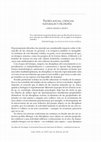articles by Norio Matsushima
The ω-helix is a modification of the α-helix. The α-helix has 3.6 residue in a single turn (3.6 1... more The ω-helix is a modification of the α-helix. The α-helix has 3.6 residue in a single turn (3.6 13-helix), while the ω-helix (4.0 13-helix) has four residue per turn, although both are characterized by consecutive (i ← i +4) hydrogen bonds. Until now the ω-helix has been identified only in synthetic polypeptides of derivatives of aspartic acid and cysteine. However, recent analysis of The Protein Data Bank by a total least-squares method for fitting a helix to data points (called the HELFIT program) demonstrated that right-handed ω-helices actually occur in proteins. In this review we describe structural feature of ω-helices in synthetic polypeptides and proteins and address functional roles of many ω-helices identified in proteins including Chromobacterium violaceum phenylalanine hydroxylase.
Papers by Norio Matsushima

Protein and Peptide Letters, Jul 1, 2023
Background: Leucine-rich repeats (LRRs) occurring in tandem are 20 ⎼ 29 amino acids long. Eleven ... more Background: Leucine-rich repeats (LRRs) occurring in tandem are 20 ⎼ 29 amino acids long. Eleven LRR types have been recognized; they include plant-specific (PS) type with the consensus of LxxLxLxxNxL SGxIPxxIxxLxx of 24 residues and SDS22-like type with the consensus of LxxLxLxxNxL xxIxxIxxLxx of 22 residues. Objective: A viral LRR protein in metagenome data indicated that most of the LRRs (5/6 = 0.83) are represented by the consensus of LxxLDLxxTxV SGKLSDLxxLTN of 23 residues. This LRR shows a dual characteristic of PS and SDS22-like LRRs (called PS/SDS22-like LRR). A comprehensive similarity search was performed under the hypothesis that many proteins contain LRR domains consisting of only or mainly PS/SDS22-like LRR. Methods: Sequence similarity search by the FASTA and BLAST programs was performed using the sequence of this PS/SDS22-like LRR domain as a query sequence. The presence of PS/SDS22-like LRR was screened within the LRR domains in known structures. Results: Over 280 LRR proteins were identified from protists, fungi, and bacteria; ~ 40% come from the SAR group (the phyla Alveolate and Stramenopiles). The secondary structure analysis of PS/SDS22-like LRRs occurring sporadically in the known structures indicates three or four type patterns of secondary structures. Conclusion: PS/SDS22-like LRR forms an LRR class with PS, SDS22-like and Leptospira-like LRRs. It appears that PS/SDS22-like LRR is a chameleon-like sequence. A duality of two LRR types brings diversity.
FEBS Letters, 1999
Small-angle X-ray scattering and nuclear magnetic resonance were used to investigate the structur... more Small-angle X-ray scattering and nuclear magnetic resonance were used to investigate the structural change of calcium-bound calmodulin (Ca 2+ /CaM) in solution upon binding to its antagonist, N-(6-aminohexyl)-5-chloro-1-naphthalenesulfonamide (W-7). The radius of gyration was 17.4 þ 0.3 A î for Ca 2+ /CaM-W-7 with a molar ratio of 1:5 and 20.3 þ 0.7 A î for Ca 2+ /CaM. Comparison of the radius of gyration and the pair distance distribution function of the Ca 2+ /CaM-W-7 complex with those of other complexes indicates that binding of two W-7 molecules induces a globular shape for Ca 2+ /CaM, probably caused by an inter-domain compaction. The results suggest a tendency for Ca 2+ /CaM to form a globular structure in solution, which is inducible by a small compound like W-7.
Journal of Japanese Society of Biorheology, 2004

Gene, 2022
Leucine rich repeats (LRRs) occurring in tandem are 20 - 29 amino acids long. Eleven LRR types ha... more Leucine rich repeats (LRRs) occurring in tandem are 20 - 29 amino acids long. Eleven LRR types have been recognized. Sequence features of LRRs from viruses were investigated using over 600 LRR proteins from 89 species. Directly before, metagenome data of nucleo-cytoplasmic large dsDNA viruses (NCLDVs) have been published; the 2,074 NCLDVs encode 199,021 proteins. From the NCLDVs 547 LRR proteins were identified and 502 were used for analysis. A comprehensive analysis of TpLRR and FNIP that belong to an LRR type was first performed. The repeating unit lengths (RULs) in five types are 19 residues which is the shortest among all LRRs. The RULs of eight LRR types including FNIP are one to five residues shorter than those of the known, corresponding LRR types. The conserved hydrophobic residues such as Leu, Val or Ile in the consensus sequences are frequently substituted by cysteine at one or two positions. Four unique LRR motifs that are different from those identified previously are observed. The present study enhances the previous result that the sequence novelty is a general feature of viral LRR proteins. An evolutionary scenario of short or unique LRR was discussed.

Biochimica et Biophysica Acta (BBA) - Proteins and Proteomics, 2021
Leucine rich repeats (LRRs) with 20-30 residues form a super helix arrangement. Individual LRRs a... more Leucine rich repeats (LRRs) with 20-30 residues form a super helix arrangement. Individual LRRs are separated into a highly conserved segment with a highly conserved (HCS) and a variable segment (VS). In LRRs short β-strands in HCS stack in parallel, while VS adopts various secondary structures. Among eleven classes recognized, only RI-like, Cysteine-containing (CC), and GALA classes adopt an α-helix. However, the repeat unit lengths are usually different from each other. We performed some analyses based on the atomic coordinates in the known LRR structures. In the VS consensuses of the three classes, position 8 in the VS part is, in common, occupied by conserved aliphatic residue adopting an α-helix. This aliphatic residue is near to the two conserved hydrophobic residues at position 4 (in the center of β-strands) in two adjacent HCS parts. The conserved aliphatic residue plays a crucial role to preserve two parallel β-strands.

Protein & Peptide Letters, 2019
Background: Plant peptide hormones play a crucial role in plant growth and development. A group o... more Background: Plant peptide hormones play a crucial role in plant growth and development. A group of these peptide hormones are signaling peptides with 5 - 23 amino acids. Flagellin peptide (flg22) also elicits an immune response in plants. The functions are expressed through recognition of the peptide hormones and flg22. This recognition relies on membrane localized receptor kinases with extracellular leucine rich repeats (LRR-RKs). The structures of plant peptide hormones - AtPep1, IDA, IDL1, RGFs 1- 3, TDIF/CLE41 - and of flg22 complexed with LRR domains of corresponding LRRRKs and co-receptors SERKs have been determined. However, their structures are well not analyzed and characterized in detail. The structures of PIP, CEP, CIF, and HypSys are still unknown. Objective: Our motivation is to clarify structural features of these plant, small peptides and Flg22 in their bound states. Methods: In this article, we performed secondary structure assignments and HELFIT analyses (calculatin...

Protein & Peptide Letters, 2019
Mutations in the genes encoding Leucine Rich Repeat (LRR) containing proteins are associated with... more Mutations in the genes encoding Leucine Rich Repeat (LRR) containing proteins are associated with over sixty human diseases; these include high myopia, mitochondrial encephalomyopathy, and Crohn’s disease. These mutations occur frequently within the LRR domains and within the regions that shield the hydrophobic core of the LRR domain. The amino acid sequences of fifty-five LRR proteins have been published. They include Nod-Like Receptors (NLRs) such as NLRP1, NLRP3, NLRP14, and Nod-2, Small Leucine Rich Repeat Proteoglycans (SLRPs) such as keratocan, lumican, fibromodulin, PRELP, biglycan, and nyctalopin, and F-box/LRR-repeat proteins such as FBXL2, FBXL4, and FBXL12. For example, 363 missense mutations have been identified. Replacement of arginine, proline, or cysteine by another amino acid, or the reverse, is frequently observed. The diverse effects of the mutations are discussed based on the known structures of LRR proteins. These mutations influence protein folding, aggregation,...
Seibutsu Butsuri, 2011
BtoLhem bniv iCwwT We have doLumented that protein proLeins thiough its 30kDa FERM domain reglon ... more BtoLhem bniv iCwwT We have doLumented that protein proLeins thiough its 30kDa FERM domain reglon m lts ca]modutin(CaM)boundtoGHPandregulated4 proteins rNunomura et ai we determmed the CaM bindmg site CaM ellP complcx by NMR analysis bmding to pepG ]RiiS bmding The hehx content ofpepG wag 4I ra bascd on CD measuiement pepGtCaM tormed Although GHP CaMIGHP forrned

The protein journal, Jun 1, 2018
Leucine rich repeats (LRRs) are present in over 100,000 proteins from viruses to eukaryotes. The ... more Leucine rich repeats (LRRs) are present in over 100,000 proteins from viruses to eukaryotes. The LRRs are 20-30 residues long and occur in tandem. LRRs form parallel stacks of short β-strands and then assume a super helical arrangement called a solenoid structure. Individual LRRs are separated into highly conserved segment (HCS) with the consensus of LxxLxLxxNxL and variable segment (VS). Eight classes have been recognized. Bacterial LRRs are short and characterized by two prolines in the VS; the consensus is xxLPxLPxx with Nine residues (N-subtype) and xxLPxxLPxx with Ten residues (T-subtype). Bacterial LRRs are contained in type III secretion system effectors such as YopM, IpaH3/9.8, SspH1/2, and SlrP from bacteria. Some LRRs in decorin, fribromodulin, TLR8/9, and FLRT2/3 from vertebrate also contain the motifs. In order to understand structural features of bacterial LRRs, we performed both secondary structures assignments using four programs-DSSP-PPII, PROSS, SEGNO, and XTLSSTR-a...











Uploads
articles by Norio Matsushima
Papers by Norio Matsushima